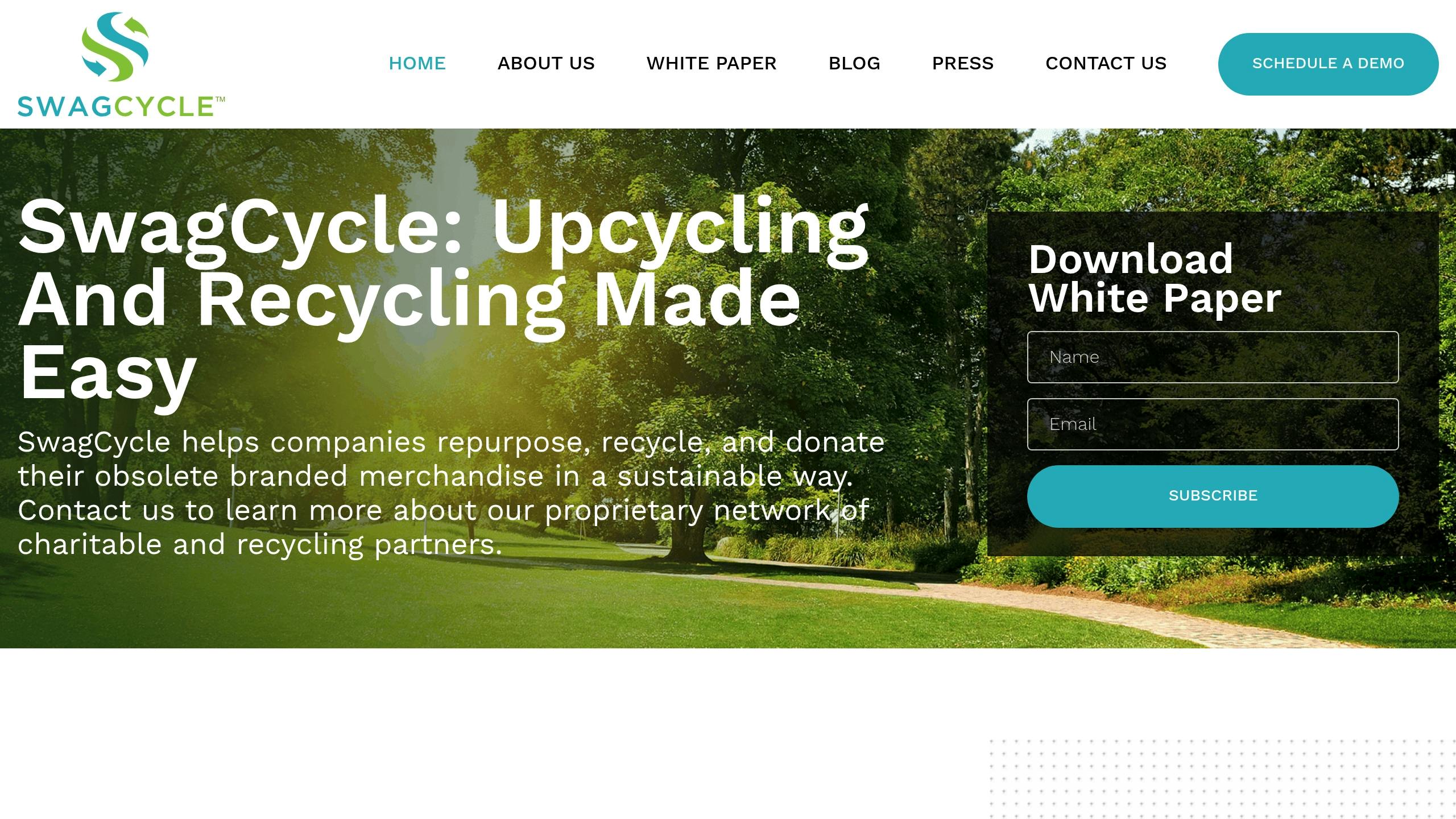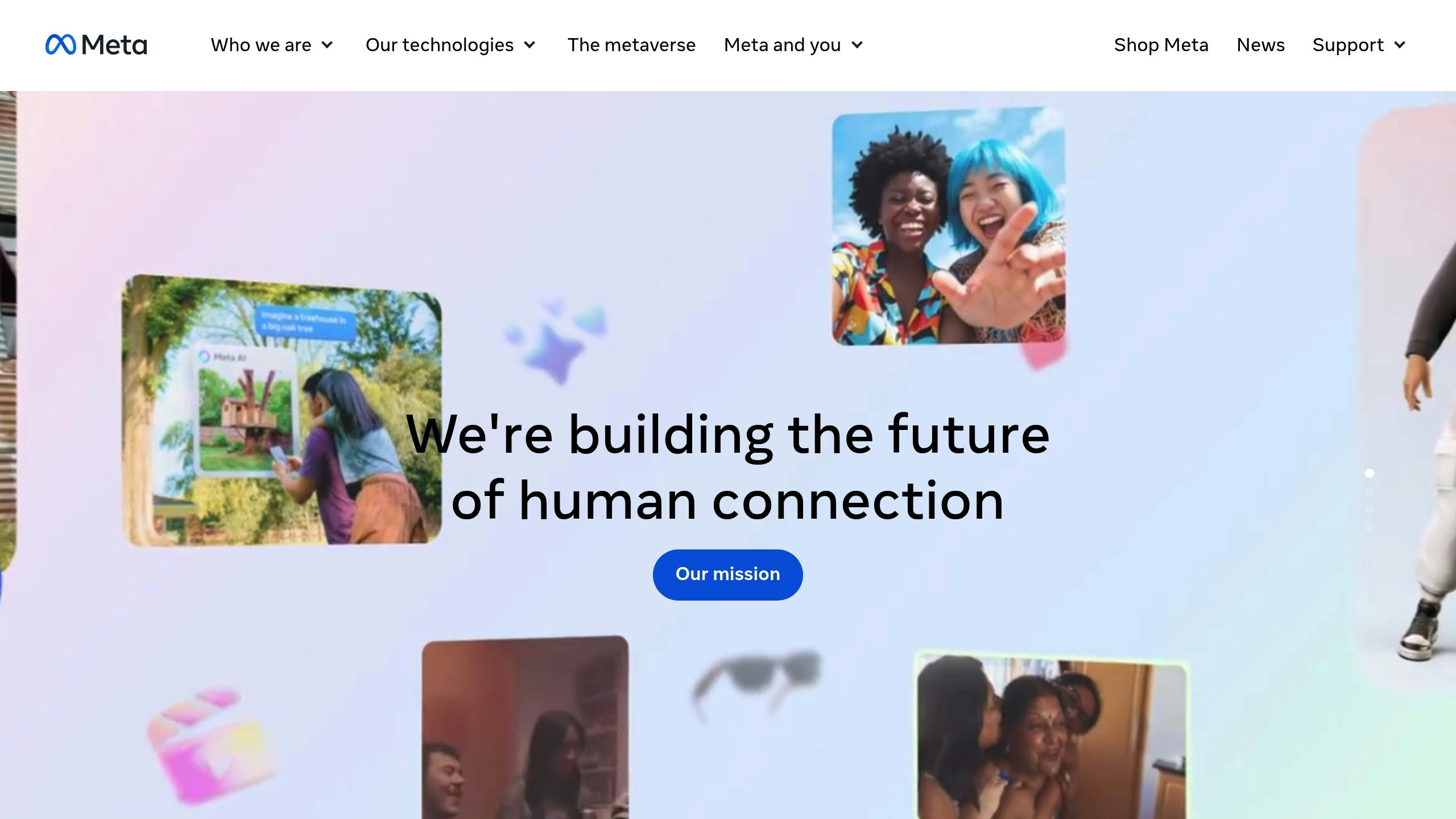
Upcycling Case Study: SwagCycle Success
SwagCycle has repurposed over 1.4 million promotional items since 2019, saving $2.6 million in waste management costs and achieving an 85% landfill diversion rate. Companies like Meta have partnered with SwagCycle to turn outdated merchandise into donations and recycled materials, aligning with sustainability goals while cutting costs.
Key Takeaways:
- Process: SwagCycle assesses items, redistributes them via donation/recycling, and measures impact.
- Results: Saved $18,000 annually for a tech firm by clearing inventory; reduced CO2 emissions by 6.5kg per upcycled shirt.
- Challenges: Polyester and mixed-material items are hard to recycle; logistics and compliance add costs.
- Tools: Stitchi software tracks materials, rates sustainability, and automates recycling logistics.
SwagCycle’s approach combines environmental responsibility with business benefits, making it a model for sustainable branding.
Related video from YouTube
SwagCycle's Upcycling Process

SwagCycle follows a structured method to upcycle promotional products, based on their three-phase operational framework.
How Products Are Assessed
SwagCycle evaluates items through a detailed three-step process to determine the best route for each product. Here’s how they break it down:
| Criteria | Action | Outcome |
|---|---|---|
| Brand Visibility | Check for logo removal | Decide between donation or recycling |
| Material Type | Analyze composition | Choose the right processing method |
| Safety Compliance | Verify regulations | Separate hazardous materials |
| Item Condition | Assess quality | Decide on reuse or recycling |
For items made of mixed materials, SwagCycle disassembles them into individual parts. For example, they separate metal caps from plastic bottles to ensure each component is processed correctly and efficiently.
Partnerships for Charity and Recycling
SwagCycle works with a wide network of specialized partners to handle various materials. These include organizations like Dress for Success, which focuses on professional clothing, Delivering Good, which aids disaster relief efforts, and textile processors that turn 350,000 pounds of misprinted items into industrial rags every year [1][4]. For electronics, their partnership with Call2Recycle ensures proper battery and e-waste management [1].
Numo, a creative upcycling partner, adds a unique touch to the process. National Sales Manager Jim Martin explains:
"Our process calculates material yields precisely - we clean/prep materials before cutting/sewing upcycled products" [6]
Measuring Success
SwagCycle uses specific metrics to meet corporate ESG goals and showcase the results of their upcycling efforts. These include:
- Textile reuse rate: 78%, five times higher than the industry average [1][4]
- Carbon reduction: 6.5kg of CO2 saved per upcycled shirt [2]
- Efficient distribution: Tailored to regional needs
The company’s smart distribution approach takes into account:
- Local requirements of beneficiaries
- Cost-effective shipping
- Donor priorities
This method not only helps companies meet regional sustainability regulations but also ensures materials are handled efficiently and responsibly.
Meta Rebranding Project Results

Project Overview
Meta's 2021 rebranding presented a logistical puzzle, particularly in managing promotional items scattered across multiple corporate locations [4]. SwagCycle stepped in with a structured approach, showcasing its expertise in handling large-scale redistribution and inventory management.
SwagCycle advises companies to plan "reverse logistics" 6-12 months before a rebrand. This preparation focuses on two key goals:
- Protecting brand integrity during the transition
- Efficiently disposing of outdated inventory in an eco-friendly way
To tackle the challenges of Meta's rebrand, SwagCycle introduced a detailed tracking system. This included centralized collection hubs and a digital chain-of-custody process [2][4]. Such a method was essential to handle the sheer volume and sensitivity of Meta's branded materials.
Project Results
The Meta rebranding project highlighted how upcycling can align with both environmental and financial priorities. Although specific financial figures remain undisclosed, the initiative achieved impressive results across several areas:
| Impact Category | Achievement | Details |
|---|---|---|
| Waste Diversion | Over 90% for apparel | Accomplished through donations and textile recycling [4] |
| Cost Reduction | 30-60% savings | Savings compared to traditional disposal methods, including storage and landfill fees [2] |
| Environmental Impact | Tangible improvements | Supported Meta's commitment to UN Sustainable Development Goals (SDGs) [4][3] |
SwagCycle's reporting system played a key role in documenting the project's success. It provided:
- Certified recycling documentation and reports aligned with GRI standards [2][4]
- Detailed donation receipts to assist with tax filings
These results underline how strategic planning and sustainable practices can make a measurable difference.
sbb-itb-6f489d9
Business Benefits of Upcycling
SwagCycle's upcycling approach offers more than just individual project wins like Meta's rebrand - it brings measurable advantages to businesses.
Cutting Waste Management Costs
By diverting 1.4 million items, companies have saved $2.6 million in waste management expenses [4]. For instance, a Boston-based tech firm slashed $18,000 in yearly storage fees by clearing 5,000 square feet of promotional inventory through textile recycling partnerships [1][4]. SwagCycle's streamlined process wraps up projects in about three weeks, compared to the typical 6-12 months of storage delays [2].
Here’s how the numbers stack up:
- Recycling textiles costs $20 per ton, while landfill disposal runs $55 per ton.
- Battery recycling is $35 per unit versus $120 for traditional disposal.
Boosting Brand Perception with Sustainability
Upcycling doesn’t just save money - it also strengthens brand image. Surveys reveal that 68% of companies saw improved brand association after adopting upcycling programs [3]. Businesses displaying SwagCycle partnership badges enjoyed a 31% rise in repeat purchases from eco-conscious customers [5].
CreativeMC’s 2023 Earth Day campaign is a great example: they achieved a 98% diversion rate, with 65% of materials donated and 33% recycled [4]. Financially, companies using SwagCycle’s closed-loop system often cut new material costs by 15-30% for ongoing campaigns [2].
There’s more: 63% of consumers are willing to pay higher prices for brands with verified sustainability efforts [3]. YMCA Houston, for example, saw a 22% boost in donor retention after distributing 15,000 upcycled items [4].
Common Upcycling Obstacles
Material and Technical Limits
SwagCycle's efforts highlight some tough challenges in the upcycling industry, especially when it comes to materials. Polyester-based apparel, which makes up 35-40% of the swag industry, is particularly difficult to recycle. Most of it ends up as industrial cloths or insulation because recycling options are limited [4]. Items made with multiple materials, like silicone-coated products, are even harder to process. Separating these components often isn’t worth the cost [1].
For instance, SwagCycle worked on recycling double-wall stainless steel bottles and silicone straws. While technically recyclable, the high processing costs made the project unviable [4]. Turning promotional items into new products requires thorough cleaning and preparation, which can increase production time and costs by 30-50% compared to starting with fresh materials [6].
| Material Challenge | Processing Impact | Added Cost |
|---|---|---|
| Polyester Apparel | Often repurposed as industrial cloths | --- |
| Electronics with Batteries | Needs special handling and testing | $2-5 extra per unit [1] |
| Complex Composites | Requires manual separation processes | 30-50% more processing time [6] |
Logistics and Rules
These material issues are further complicated by logistical and regulatory hurdles. For global programs, customs delays for used goods can take 8-12 days, compared to just 3-5 days for new items in 38% of countries [7]. This slows down operations and raises costs.
A 2023 YMCA project illustrates how cultural and regulatory factors add complexity. SwagCycle managed the modification of 5,000 backpacks for distribution in the Middle East. Adjustments included removing pig leather logos for cultural reasons and adding child-safe zipper pulls to meet EU standards. These changes added $3.75 per unit to the cost [4][7].
Quality control is another major hurdle. Brand safety often requires removing or obscuring logos, which costs between $0.25-$1.50 per item [4]. For electronics like power banks, additional testing is needed - SwagCycle found that 12% of donated power banks had to be re-tested before they could be reused [2].
Administrative and compliance demands also drive up costs:
- Tracking and documentation add 18-22% to expenses [4]
- Battery recycling certifications cost $500-$2,000 per project [1]
- Meeting EU safety standards adds €0.35-€1.25 per unit [7]
These challenges show how upcycling, while impactful, requires navigating a maze of technical, logistical, and regulatory barriers.
Software Tools for Product Management
SwagCycle tackles material and logistical hurdles by using tailored software solutions.
Stitchi's Tools Supporting SwagCycle's Processes
Stitchi provides tools that help SwagCycle make environmentally conscious production decisions. For example, materials get rated (like an 85/100 score for recycled polyester), and impact data shows benefits like a 91% reduction in water use when choosing organic cotton over conventional options [5].
Real-time dashboards track production metrics, offering insights such as CO2 savings. For instance, upcycling 1,000 banners saves around 320kg of carbon emissions [4]. These dashboards also integrate with quality checks, flagging materials that are hard to recycle - like silicone-lined stainless bottles [4].
| Feature | Benefit |
|---|---|
| Material Ratings | Scores materials on a 0-100 scale for sustainability |
| Water Usage Monitoring | Tracks reductions like 91% savings with organic materials |
| Carbon Emission Tracking | Highlights savings, e.g., 320kg CO2 per 1,000 upcycled banners |
| Quality Alerts | Identifies non-recyclable material combinations |
Planning for Upcycling from the Start
SwagCycle's tools also help partners incorporate upcycling into their product strategies early on. The platform uses past event data to recommend optimal production quantities, ensuring smarter planning.
When items reach the end of their lifecycle, the system simplifies recycling logistics. It connects to recycling networks via APIs and automatically generates shipping labels for partners [2][4].
The platform also tracks the impact of upcycling efforts. Reporting features reveal ROI, including a 22% boost in sustainability perception among customers after adopting upcycling programs [3][5].
For global operations, built-in compliance tools ensure materials meet international regulations. The system updates restrictions automatically and even generates customs documentation for cross-border shipments [2][4]. These features make upcycling scalable, efficient, and compliant - key for global brands looking to improve sustainability efforts.
Conclusion
SwagCycle's three-phase approach shows how upcycling can deliver both environmental benefits and business gains. By focusing on assessment, redistribution, and measuring impact, their model highlights how companies can align sustainability with practical outcomes.
Their partners not only cut waste management costs but also enhance their brand reputation by committing to verified eco-friendly initiatives. This approach underscores the value of incorporating sustainability into the lifecycle of promotional products.
Stitchi's tools, like real-time dashboards and material ratings, play a key role in supporting these efforts. By enabling sustainable design, inventory tracking, and integration with recycling networks, Stitchi helps businesses turn sustainability goals into tangible results. These technologies provide the backbone for scaling up the processes covered in this case study.
As discussed, AI-assisted product assessment could take these efforts even further, simplifying upcycling operations as sustainability expectations grow [7]. SwagCycle's framework offers a clear path forward for companies aiming to meet environmental goals while maintaining business success.